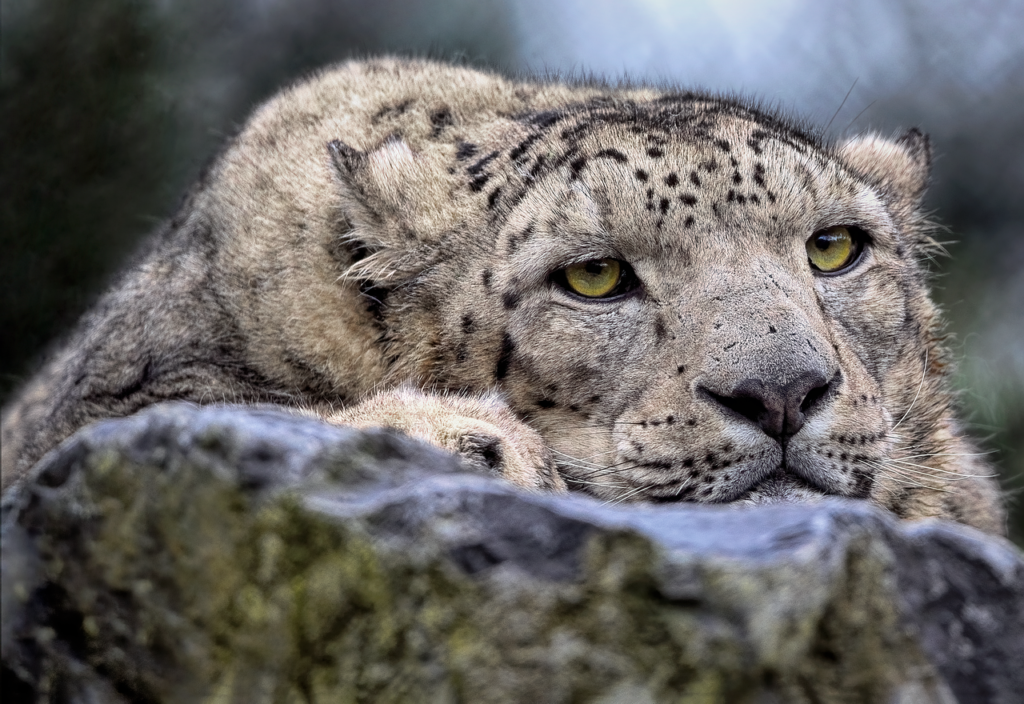In the high mountains of Gilgit-Baltistan, Pakistan, a new project is bringing hope to both villagers and wildlife. AI-powered cameras are now being used to stop snow leopards from attacking livestock. These smart cameras send warning messages to farmers when a snow leopard enters the area. This helps people move their animals to safety before it’s too late.
Snow leopards are powerful cats, but they are shy. Unlike other big cats, they don’t growl. Instead, they purr when people come close. They live in rocky, cold places, and are very hard to spot. That’s why they are called the “ghosts of the mountains.”
Lovely, the Leopard Who Can’t Go Home
Twelve years ago, a baby snow leopard was found in Gilgit-Baltistan. She had lost her mother and was all alone. People rescued her and named her “Lovely.” Since then, she has lived under human care.
Lovely was never able to learn how to hunt on her own. She depends on people for food. Because of this, she cannot live in the wild. Her caretaker, Tehzeeb Hussain, says, “If we let her go, she would probably attack livestock and get killed in return.”
This is a sad reality for many snow leopards. Even though laws protect them, the World Wide Fund for Nature (WWF) says 221 to 450 snow leopards are killed every year. Many are killed in revenge after they attack farm animals.
Right now, only about 4,000 to 6,000 snow leopards are left in the wild. Pakistan is home to around 300 of them, making it the third-largest snow leopard population in the world.
A Smart New Plan to Prevent Attacks
To stop the killing, WWF joined hands with the Lahore University of Management Sciences. They created solar-powered AI cameras that can spot snow leopards in real time. These cameras are set up high in the mountains, around 3,000 meters above sea level.
The cameras use smart software to tell the difference between people, animals, and snow leopards. When a leopard is seen, the system sends a message to nearby farmers. This gives them time to bring their animals to safety.
Asif Iqbal, a conservationist with WWF Pakistan, says the cameras are doing well. He points to fresh snow leopard tracks on a mountain trail. “These are fresh tracks,” he says, showing how the system works.
Right now, ten cameras are being tested in three villages in Gilgit-Baltistan. It took three years to train the software to recognize different animals. Asif shows a dashboard on his computer. It labels him correctly as a human in most pictures. But in one image, it marks him as both human and animal. “That’s probably because of my thick fleece,” he jokes.
One camera even caught a snow leopard at night, raising her tail to mark her territory. “That’s a mother,” says Asif. “She’s claiming her space.”
Facing Hard Weather and Harder Questions
Building the system was not easy. The team tested many batteries to find one that works in freezing weather. They also painted the cameras with dull colors so they don’t shine in the sun. The lenses are protected by metal covers. If the network goes down, the cameras still save the footage on-site.
Still, there are problems. Landslides have damaged some solar panels. Also, in many villages, people are not ready to accept the cameras. At first, some locals cut wires or covered the cameras with blankets.
Respecting traditions is a big part of this project. In many places, the cameras had to be moved from paths used by women, to protect their privacy. WWF also asks villagers to sign agreements that they won’t share footage with poachers. Until that happens, the system cannot be turned on in those areas.
Trust Takes Time
One villager, Sitara, lost six sheep to a snow leopard in January. “I raised them for three to four years. I lost everything in one day,” she says. After the attack, she stayed in bed for days. When asked about the new AI system, she says, “My phone rarely works here. How can a message help?”
Still, things are slowly changing. In Khyber village, elders now better understand why snow leopards matter. WWF explains that these cats eat ibex and blue sheep. If those animals grow too many, they overgraze the grasslands. That hurts the livestock too.
Yet, not everyone is convinced. One farmer says, “We used to have 40 to 50 sheep. Now we have only four or five. The leopards and ibex take away our grass and our animals.”
Climate Change Adds More Risk
The rising temperature is pushing farmers to higher grounds. That puts them even closer to snow leopard habitats. This makes the problem worse.
However, strong laws are now in place. In 2020, three men were jailed for killing a snow leopard in Hoper Valley. One of them even posted the pictures online. Now, such punishments help protect the cats.
More Tools Coming Soon
The team behind the AI cameras knows that this is just the beginning. In September, they plan to add more tools—like sounds, lights, and smells—to scare snow leopards away from villages.
Saving these rare animals takes time, trust, and new ideas. But step by step, the mission continues. These cameras may be the key to helping both people and leopards live in peace.


